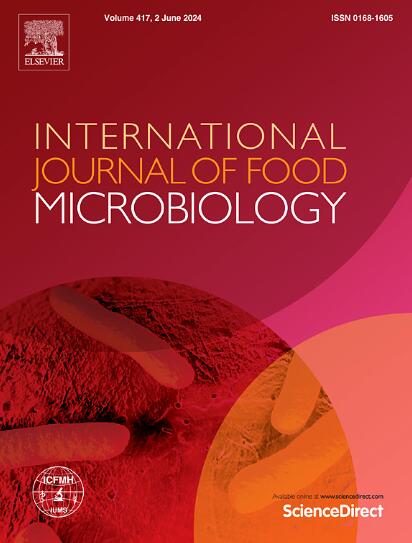铁竞争在柑橘采后果实中对三种主要病原菌拮抗作用中的作用
IF 5.2
1区 农林科学
Q1 FOOD SCIENCE & TECHNOLOGY
International journal of food microbiology
Pub Date : 2025-07-03
DOI:10.1016/j.ijfoodmicro.2025.111338
引用次数: 0
摘要
本研究系统地研究了pulcherrima XX04与指状青霉、意大利青霉和柑橘金地霉争夺铁离子控制柑橘采后主要病原菌的机制。外源Fe3+的添加显著降低了产色素酵母在琼脂培养基和果实上对这些病原菌的抑制活性。Pearson相关分析显示,色素生成与拮抗效果呈正相关。对比分析了三种病原菌对PDA培养基和柑橘伤口的铁捕获能力,结果表明,pulcherrima XX04具有更强的铁捕获能力。在含有pulcherrimin的PDA (pull -PDA)固体培养基上进行的菌落生长活力测定表明,M. pulcherrima XX04可以利用pulcherrimin结合的铁进行生长和代谢,并进一步证实了PUL3的显著上调,PUL3是一种被认为参与利用细胞外pulcherrimin-铁复合物的转运体,而病原体表现出有限或没有能力从该来源吸收铁。对3种病原菌在限铁、富铁和补铁条件下的生长试验表明,对缺铁最敏感的是digitatum,其次是P. italicum,而G. citrii -aurantii对低铁环境的耐受性最高。用琼脂孔扩散法对两种专用螯合剂2,2′-二吡啶和tropolone进行铁螯合敏感性试验,进一步验证了这一观察结果。总的来说,在铁限制的共存环境中,产色素酵母M. pulcherrima XX04可能比三种被测试的病原体具有更大的竞争和获取铁的能力。这种能力有助于诱导M. pulcherrima对各种真菌病原体的铁剥夺,并代表其生物防治效果的关键决定因素。我们的发现为阐明拮抗酵母介导的竞争性铁消耗机制提供了新的见解。此外,基于诱导铁饥饿的策略可能为柑橘类水果采后病害的管理提供一个有希望的替代方案。本文章由计算机程序翻译,如有差异,请以英文原文为准。
The role of iron competition in the antagonistic action of Metschnikowia pulcherrima against three major pathogenic fungi on postharvest citrus fruit
This study systematically investigated how Metschnikowia pulcherrima XX04 competes with Penicillium digitatum, Penicillium italicum, and Geotrichum citri-aurantii for iron ions to control these major postharvest citrus pathogens. Exogenous Fe3+ addition significantly reduced the inhibitory activity of the pigment-producing yeast against these pathogens on both agar medium and fruit. Pearson correlation analysis revealed a strong positive relationship between pigment production and antagonistic effectiveness of M. pulcherrima XX04. Comparative analysis of iron-capturing proficiency between M. pulcherrima XX04 and three pathogenic fungi on PDA medium and citrus wounds indicated that M. pulcherrima XX04 exhibited superior iron sequestration capabilities. Colony growth viability assay performed on Pulcherrimin-containing PDA (Pul-PDA) solid medium showed M. pulcherrima XX04 could utilize pulcherrimin-bound iron for growth and metabolism, and further evidenced by the significant upregulation of PUL3, a putative transporter involved in the utilization of extracellular pulcherrimin-iron complexes, whereas the pathogens exhibited limited or no ability to assimilate iron from this source. Growth assay of three pathogens under iron-limited, iron-rich, and iron-replenish conditions showed that P. digitatum was the most sensitive to iron deficiency, followed by P. italicum, while G. citri-aurantii displayed the highest tolerance to low-iron environments. This observation was further validated by iron chelation sensitivity assays using the agar well diffusion method with two specialized chelators, 2,2′-dipyridyl and tropolone. Overall, the pigment-producing yeast M. pulcherrima XX04 may have a greater capacity than the three tested pathogens to compete for and acquire iron in an iron-limited coexistence environment. This capability facilitates the induction of iron deprivation by M. pulcherrima against various fungal pathogens and represents a key determinant of its biocontrol efficacy. Our findings provide new insights into elucidating the mechanism of competitive iron consumption mediated by antagonistic yeasts. Furthermore, strategies based on inducing iron starvation could offer a promising alternative for managing postharvest diseases in citrus fruits.
求助全文
通过发布文献求助,成功后即可免费获取论文全文。
去求助
来源期刊
CiteScore
10.40
自引率
5.60%
发文量
322
审稿时长
65 days
期刊介绍:
The International Journal of Food Microbiology publishes papers dealing with all aspects of food microbiology. Articles must present information that is novel, has high impact and interest, and is of high scientific quality. They should provide scientific or technological advancement in the specific field of interest of the journal and enhance its strong international reputation. Preliminary or confirmatory results as well as contributions not strictly related to food microbiology will not be considered for publication.

 求助内容:
求助内容: 应助结果提醒方式:
应助结果提醒方式:


